Nicholas J. Cull is a scholar of international communication with a particular interest in the history of how nation states and other international actors achieve goals through engagement with foreign publics. I’ve written about the propaganda in World War Two and the Cold War and have researched the UN’s publicity campaigns around the struggle against Apartheid in South Africa. Every now and again I am aware of the way in which messages from international actors have had a personal impact on me. One such campaign was the UN’s year of the disabled, 1981.
This is the second blog that is part of our crowdsourcing initiative in which we asked the public to contribute their knowledge about the impact of the International Year of Disabled Persons through blogposts. For more information see: https://rethinkingdisability.net/call-for-blogposts/
How the UN Year for Disabled Persons in 1981 inspires a mountain activity holiday project for kids with intellectual disabilities that still helps a participant decades later
My story of the UN year of the disabled takes place in Britain. I was fifteen years old and attending Bishop Wand Church of England secondary school in the quiet west of London town of Sunbury-on-Thames. Our headmaster announced that autumn that the school would participate in the upcoming UN year of the disabled. He appealed for ideas. He was particularly keen that the school should be accessible to wheelchair users which was difficult given that it was on multiple floors with no lifts. He suggested that we might find innovative ways to get around this other than spending money on installing lifts. On several occasions, he made the crazy suggestion that the rugby team might be employed carrying disabled kids in their chairs up and downstairs! Eventually, a more realistic plan took shape. The school would be organizing a project whereby pupils would take intellectually disabled kids from a nearby special school [Manor Mead in Shepperton] on a mountain activity holiday in Snowdonia, North Wales. I volunteered immediately. My eagerness to be part of the project sprang from the mountain activity part rather than the disability part. I had visited the destination (the Christian Mountain Centre in Tremadoc) on a school trip a couple of years before and was keen to return.
The idea of the trip was that we would be working to give the kids with disabilities a good time and their parents respite. I don’t recall any talk about helping us typical kids to understand disability, rather it was framed as an extension of a school philosophy as a church-linked institution of doing something good in the world. There was a strong overlap between the volunteers and students exploring personal faith. We brainstormed for ways to raise money. The eventual plan was that pupils would hold a ‘bring-and-buy’ sale. The highest value items were auctioned at an evening event by a professional auctioneer who donated his services. We had the UN disability year logo on the publicity materials. The one item that sticks in my mind from the auction was a large signed photograph by Lord Snowden of a funeral gondola in Venice.
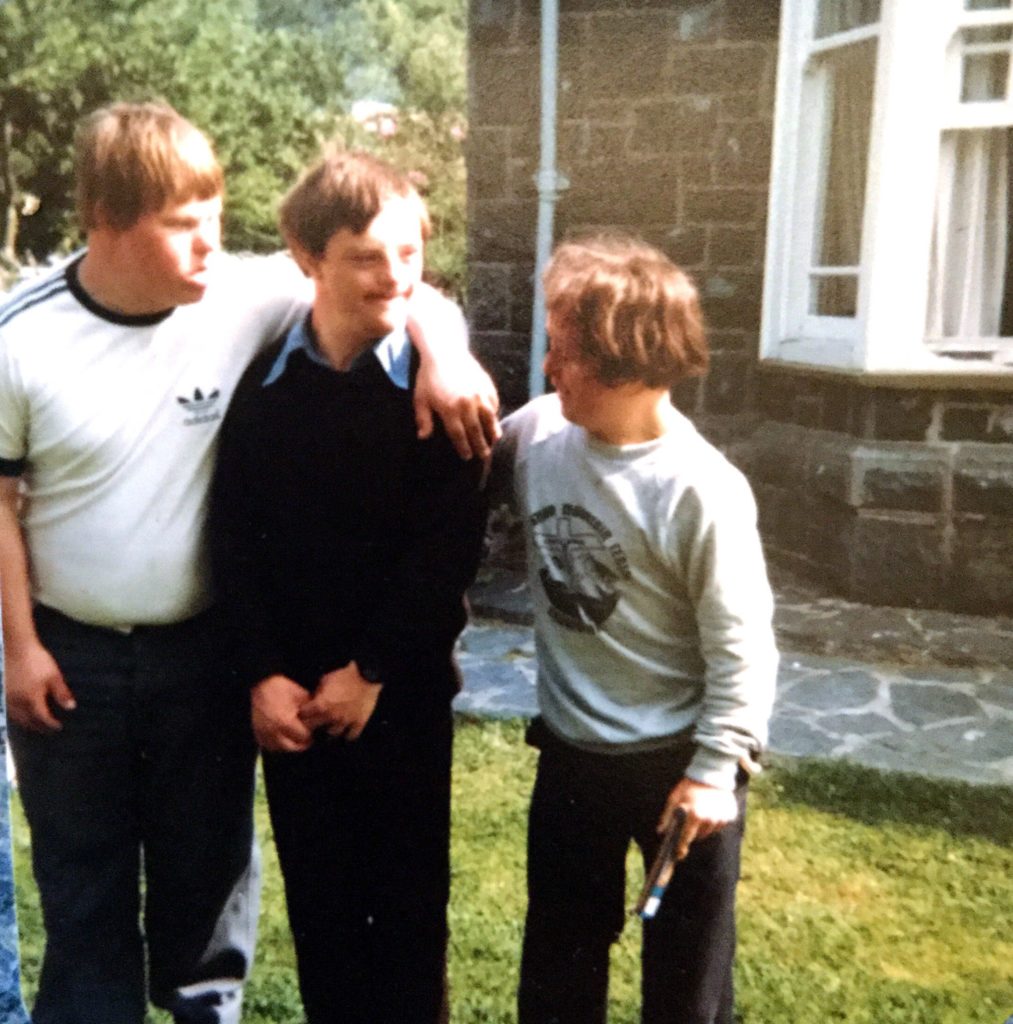
Richard and Paul outside the mountain center just before heading home, pictures by Vicky Barrett
As the plan developed my fellow volunteers and I paid a visit to the special school and saw a group of the kids and get a sense of them. We met the teacher from the school who would be coming along on the trip. I am sorry to say that up to that point I had had limited exposure to disability. The existence of ‘special schools’ meant that my generation of British children had little face-to-face experience of kids with intellectual disabilities. Unless we had immediate neighbors or family members with disabilities, those kids existed in a separate world which we would only glimpse briefly as when their school bus drove along the main road on its daily round. In the absence of experience fantasy filled in. It pains me to admit this, but much of the language of the daily round of teasing and insulting one another invoked disability. We would stick our tongue into our lower lip and imitate a person struggling to speak, use the names of disabilities like ‘spastic’ as epithets and even use the name of a local mental hospital as a term of abuse. Kids from western parts of my school’s catchment area called each other Botley after Botleys Park Hospital, Chertsey; kids from the eastern part called each other Normansfield after Normansfield in Teddington, which I learned as an adult was founded by the man who identified Down Syndrome, John Langdon Down. Our language was a cover for fear of the unknown. As a younger child I had even actively avoided exposure to images of disability in pamphlets or in Sunday Schoolclasses. When the older kids started having lessons on disability awareness-type issues, learning about Helen Keller and so on I insisted on remaining with the younger kids and helping the teacher, and did so for several years! Yet the unknown is also a source of curiosity. Visiting Manor Mead school I found that there was something engaging about the kids we met: an infectious air of happiness perhaps or a lack of the kind of inhibitions that seemed so much a part of a typical British teenager’s life.
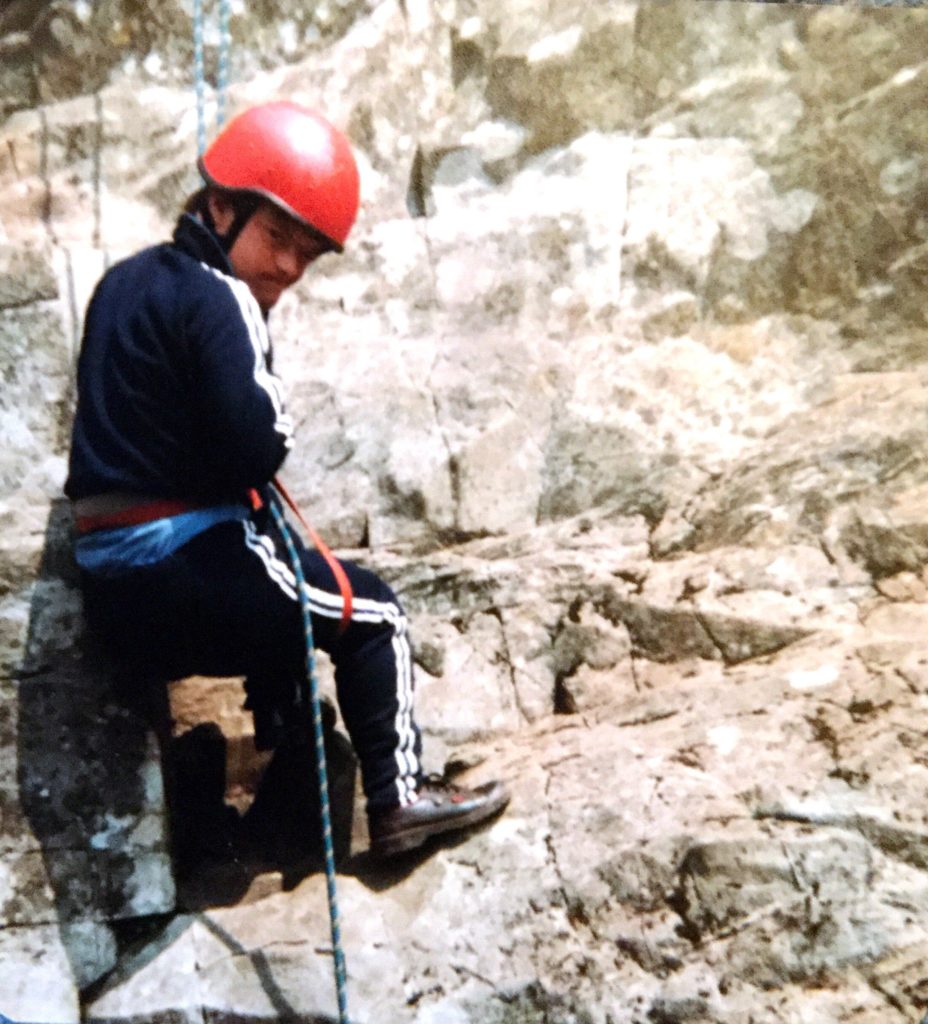
Richard repelling down a rock, picture by Vicky Barrett.
Plans proceeded well until suddenly we ran into an unforeseen problem. While there were plenty of Bishop Wand kids interested in joining the trip only five or so Manor Mead kids came forward. In retrospect, perhaps our first move should have been to actually ask the school what their pupils might need rather than devising a program and hoping for the best. The Head Teacher warned us bluntly that the trip was headed for cancellation. I shared the news at home at which point my father enters the story. My dad was also a Head Teacher but of a Middle School called St Anne’s, located in one of the less prosperous neighborhoods at the edge of Heathrow airport. He pointed out that he had children at his school who had never had a holiday who would have loved the opportunity to go to Wales. He also recalled that there was an educational fund established by the will of a certain Lord Knyvett (with funds accumulated as a result of that man foiling the famous Gunpowder Plot of 1605) to which schools in his district could apply. The concept of the trip was swiftly re-framed. The new idea was to present the trip to some of my father’s pupils as a chance for them to help the disabled kids rather than to get a holiday. With enough participants and with funds from Lord Knyvett’s charity the trip went ahead.
Looking back there was surprisingly little training given to those of us selected to provide one-on-one support for the Manor Mead kids. We didn’t know much about their capabilities or their limits. I assume the plan was that we could learn as we went along. The group included a couple of boys with Down Syndrome, a couple of more introverted lads with Autism, and one girl whose background I don’t recall. My recollection was that we were not paired with our particular charges in advance but rather were just encouraged to sit next to someone on the bus and see what happened. Getting on the bus I spotted a boy much smaller than me with Down Syndrome. He had a runny nose and wispy first beard showing on his cheeks. He was very excited and jumping around in his seat and others were passing him by. I felt drawn to him and sat down in the next seat mindful of a degree of challenge. His name was Paul and for the next week we did everything together. Some of his care was shared with my friend Vicky but many aspects were necessarily separated by gender, including the overnight care. My personal learning curve included what I now recognize as the usual milestones in learning about disability, most importantly the recognition that similarities far exceeded differences. Paul was very taken that we were both fifteen years old. I enjoyed his enjoyment of our activities, the world in general, and of me. I was profoundly challenged by the week, especially when called on to help with showering and to clean up after a couple of toilet accidents.
The attitude that took shape in me was a ‘get on with it’ feeling, accepting that there was no one but me to do a particular task. I felt my world contract to focus on his well-being for those days. We became very attached to each other. He sometimes seemed to be the one taking care of me — even on occasion attempting to feed me at dinner. Activities I recall including lots of singing, hikes, basic climbing, a trip on the famous Ffestiniog steam railway and a chilly morning in kayaks where with a helper at each end of their craft the kids got to enjoy bobbing up and down in the surf of the Irish sea. We visited slate mines, Harlech Castle (I have a picture of that) and a hill farm to see some new lambs (which fixes the trip in April or so). One of the St Anne’s kids became very attached to a foal in the field next to the center. There were only a few times when Paul’s world seemed sad. I remember that on our trip home he insisted on going on a ride designed for pre-schoolers at a motorway service station. He seemed such an isolated and forlorn figure sitting on a little blue car going round and round a circle of track, but he was happy.
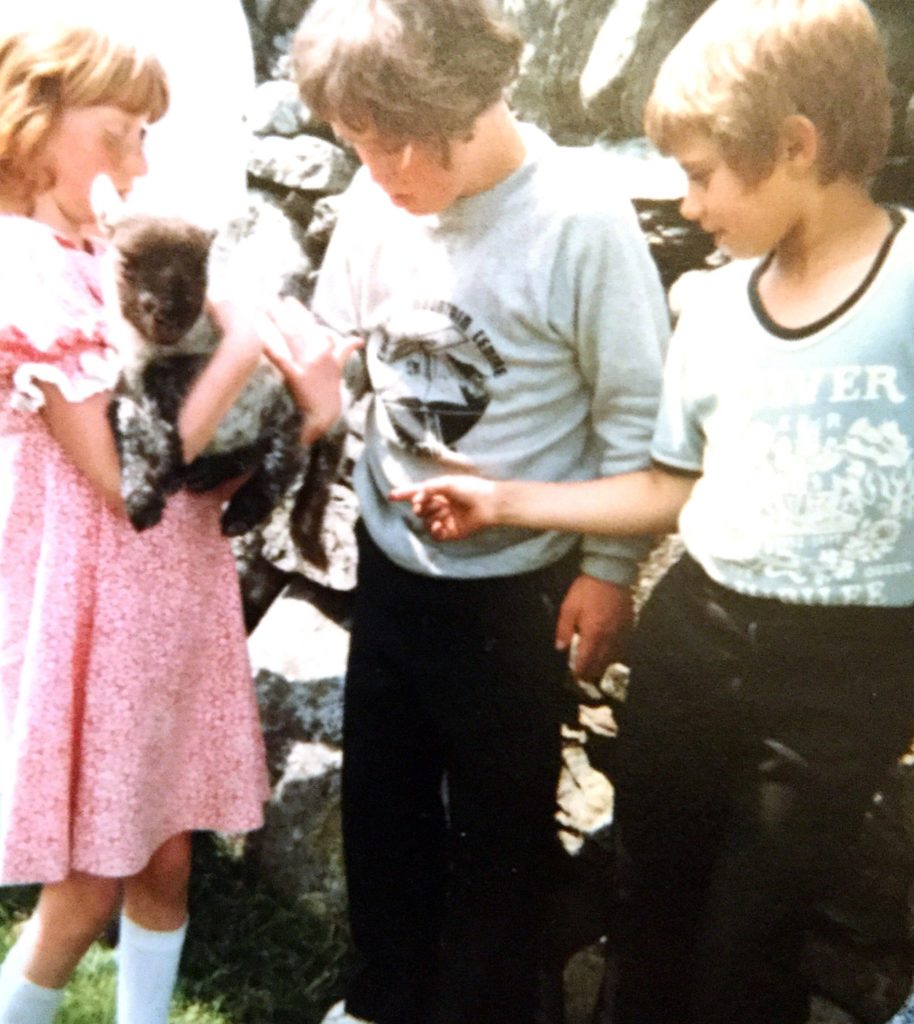
Paul and two of the St Anne’s kids meeting a lamb, picture by Vicky Barrett.
After the return to home we did a couple of events to keep up with the kids, and I remember several occasions when a fellow veteran of the trip, Jonathan, and I waited outside his house for the Manor Mead school bus to go by so we could wave to Paul and Martin, Jonathan’s friend. It was lovely to see the boys waving and doing the actions from one of the songs they’d been taught on the trip. It seemed natural that we would work to repeat the whole thing in 1982, and so we did. To help raise money we designed and sold Christmas cards. The second trip also went off wonderfully. Many of the same kids from Manor Mead and St. Annes were joined by some newcomers. As well as helping with Paul I spent some time with Richard, another young man with Down Syndrome who, like me, had a big interest in movies. He would often communicate with movie quotes which could sometimes be perfect fit for the context. By that stage some of the kids including Paul had moved over from school to a protected workshop called Fairways at Knowle Green in Staines. We visited them there one lunch hour. It seemed a cheerful place with dancing every day at noon to keep the kids moving. By 1983 our thoughts were elsewhere and I don’t recall any suggestion of a third trip. I was preparing for A level exams and hoping to go away to university and felt somehow restrained in sustaining contact with Paul. Perhaps I felt embarrassed by the extent to which my horizons were so open and his so limited like the little circle of track. I still thought about him; treasured the pictures from our trips and even prayed that I might run into him by chance and have an opening to keep contact going. I did not channel the experience into a career choice but merely thought of it as an important part of my growing up process, when I had learned that I could cope with more than I might otherwise have presumed. The experience remained a precious but private memory it was not even something I spoke about with friends or — in time — my wife. That changed in 2004.
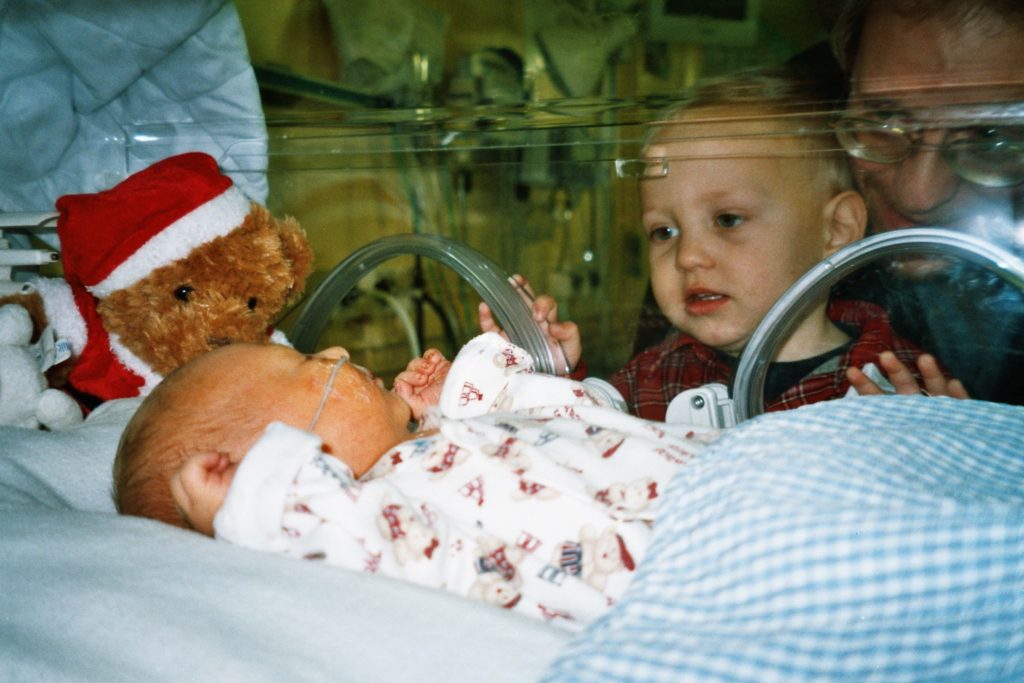
A one week old Magnus
On 4 December 2004 my wife Karen and I — then living in the East Midlands of Britain — checked into our local hospital to deliver our 2nd son. He was overdue and the doctors wanted to hurry things along. It soon became clear that there were complications. My first son had arrived two years earlier in the same room with a single midwife in attendance. My second son required an almost comic number of doctors, who seemed to proliferate in the delivery room all anxious and all focused on the expected point of the baby’s emergence rather than my wife’s face, which was occupied exchanging alarmed expressions with my own face. When our son Magnus emerged he was almost instantly whisked out of the door. I followed the doctors to the door — just a couple of paces — and realized when I looked down the corridor that they were already a good hundred feet away running to another section of the building. There was an agonizing wait and then one doctor came back. “There is’ he said (in language we later learned was recommended as best practice) ‘something unexpected.’ He looked at Karen. ‘How OLD are you?’ he asked. ’38’ she said. ‘Hmmm’ he answered. ‘Have you heard of Trisomy 21? It is also known as Down Syndrome…’ The word began to ring in my head like a giant bell. Down, Down, Down. Karen looked at me in a kind of panic and I said that I knew what it was and that I knew it was not the end of the world. Many things helped in the difficult and confusing days that followed. I was much encouraged by friends and relatives who spoke of positive experiences with disability in general and Down Syndrome in particular. One friend told me that General DeGaulle had a beloved daughter with Down Syndrome and it didn’t stop him saving France. My uncle told me of a neighbor with a teenage son with Down Syndrome and popped a copy of the man’s book on the subject into the mail, but above all I had my own experience from 1981 and 1982 of a friendship with a person more like me than he was different who I felt had made my world a bigger and a better place. ‘We can do this’ I told my wife.
I have often thought since of the significance of that UN disability year experience and how central it became. The American TV writer Emily Perl Kingsley famously compared the experience of becoming a parent to a person with Down Syndrome to planning a vacation trip to Italy and finding that the plane has landed in Holland. It is not what one expected but is an experience which has its own pleasures as well as challenges. Karen has said that when our family plane landed in Holland it helped us that I’d been there before, if only for the equivalent of a day trip. My own sense of the experience is a little more geeky. In the first book of The Lord of the Rings the character Frodo is given a magic phial of liquid by Galadriel, the queen of the wood elves, to be a light in the darkest place. In the second book, when he is in such a place, he is able to use that gift to defeat the giant spider Shelob. My experience from 1981 was like that. It was a gift which I carried for years and on what seemed to be my darkest day it gave me light. Whether the UN Year was the origin of a happy day-trip to Holland or a magical gift that I carried for years, I remain profoundly grateful.
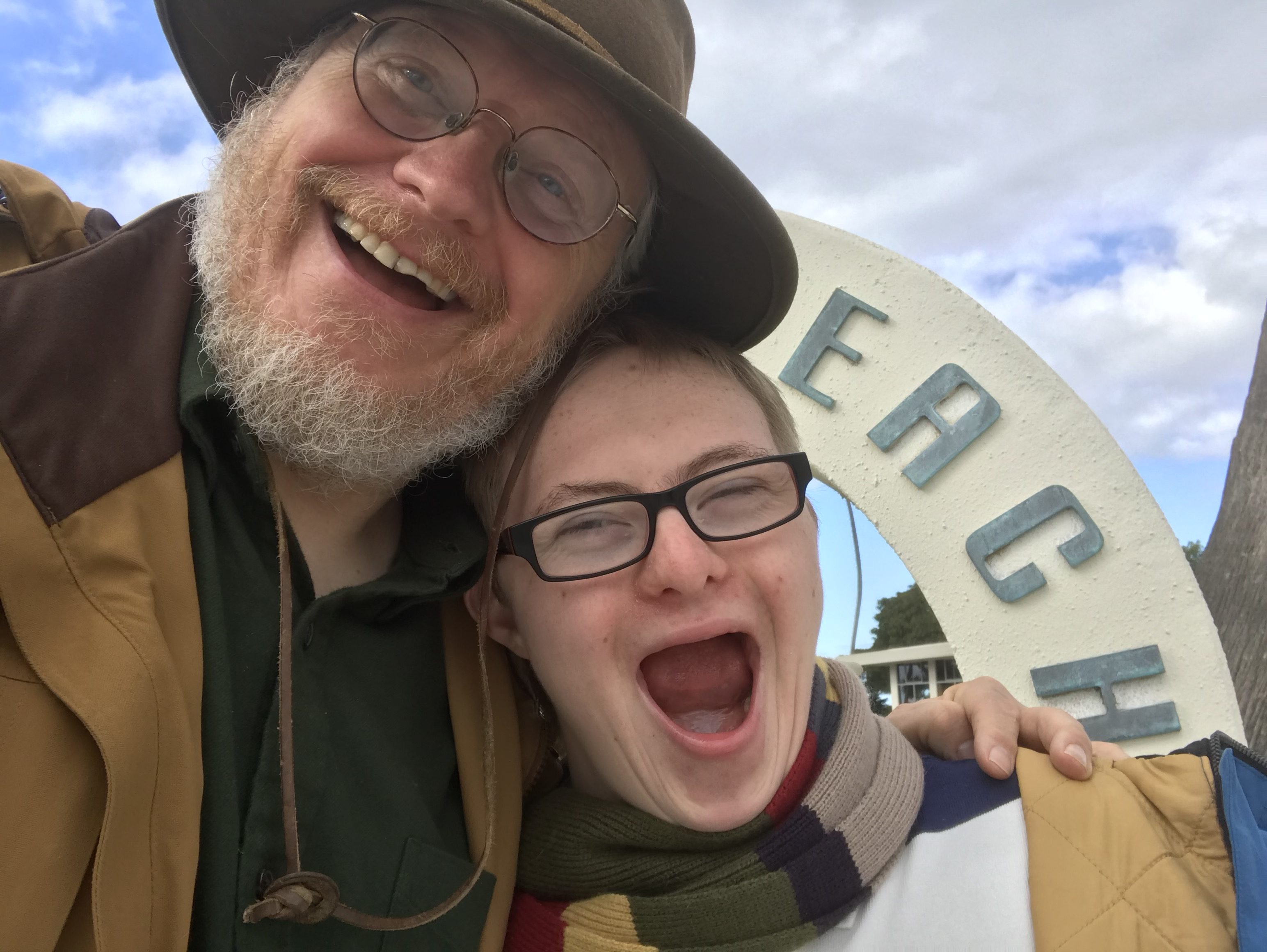
A picture of Nicholas and his son Magnus taken in early February 2020.